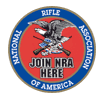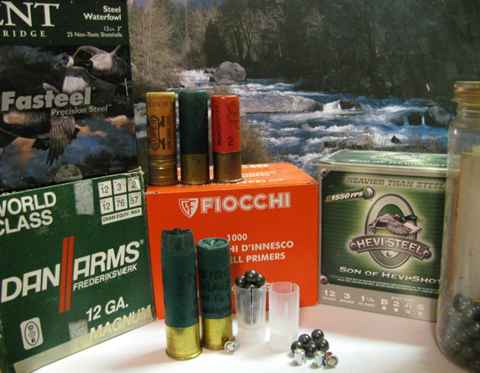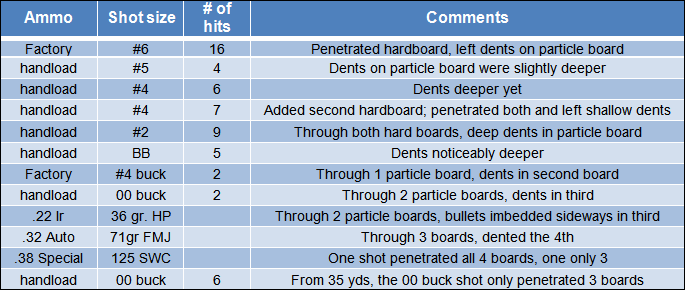
| Articles | Documents | Equipment | Events | Links | Membership | Miscellaneous | Scrapbook | Targets | What's New |
| Coarse Hail | August 2010 | |
| Gerhard Schroeder
| ||
|
In April 2010 two types of items showed up in my cave. One
was a jar containing some lead buckshot, maybe enough to fill about a box
of reloads. The other, a few pieces of particle board, approximately 17”
by 14” in size, and 5/8” thick, came about when an older small piece of
furniture got dismantled so the thing would fit into the trash can. Just
as I was about to drop them in, my twisted mind made a connection. Maybe
the particle boards could serve one more function before meeting their
final resting place.
All kinds of things have been launched from the trusted and proven 12
gauge. Aside from the original lead shot we now can choose steel,
tungsten, a variety of metal matrix heavy shot, buckshot, slugs, etc.
Even bean bags, tracers, rock salt and a stack of pennies have travelled
own someone’s smooth bore. And who knows what the militaries of this
world hurl out of a shotgun!
So I looked at that jar of buckshot. Measurements confirmed that they
were the familiar double ought buck, about .33 inches in diameter. Each
weighs about 53 grains. Even better, the Alliant reloading pamphlet
provides some data for rolling your own 00 Buck shells, and I had all
the components on hand.
Just to put this into perspective, 12 pellets of 00 Buck add up to 1½
ounces. At an advertised 1275 fps (3” magnum data) this compares
approximately to 12 shots from a .32 H&R Magnum loaded with 60-grainers
and fired simultaneously. You would not want to stand in front of it.
Ok, but neither would you want to stand in front of an unleashed dove &
quail load.
That’s where I introduced the wooden boards. Following a simple plan
I placed the particle boards behind each other, separated by about an
inch. Many probably have downed the occasional bird at some forty paces.
Once, with #2 shot, I ended the marauding habits of a coyote at about
thirty five yards, instantly. To me, therefore, it was of interest how
larger shot performed at longer ranges. Now deep into this ‘project’ I
arranged for some hardboard (1/8 inch thick), and outlined a coyote as
my target. Arbitrarily I placed the boards some 65 yards away. That
looked like a long way out with a shotgun in hand. The subsequent
assault built gradually. Shot into a dirt bank, a few initial shells
determined how high to aim to approximately center the patterns onto the
wood. Then I aimed for the coyote outline.
First up was a Remington factory load with a white “6” inked onto its
green three-inch plastic. I only had this one, don’t know from where,
don’t know what charge weight it contained. Sixteen of the number 6
pellets struck within the coyote. All penetrated the hardboard, but
then only left slight dents on the particle board behind it. That
morning required lots of walking. Take a shot, check the target, count
and mark off the impacts, records the results, walk back, take the next
shot, repeat. You get to fast-forward through this process – see table
below. All handloads were loaded alike, except I substituted with
ever-increasing shot size.
The #4 buckshot finally penetrated the two hard boards and the first
particle board. This ammo was factory Remington 3” Mag with roll crimp,
over 30 years old by the looks of it. Again, I don’t know how many
pellets were in there.
Once the 870 pump did its duty I also tried some other stuff for
comparison, since I had it along. They were a .22 pistol loaded with
Federal HP ammo, a .32 Auto loaded with 71 grain FMJs (yes, it took
quite a few of shots to finally put some into wooden boards from 65
steps away), and a .38 Special loaded with 125 grain semi-wadcutters.
So for the test results: What is practical?
While the number 6 factory load delivered decent coverage, their
effect at long distance is highly questionable. Maybe a lucky pellet
would break a dove’s wing or quail’s neck – maybe. I’d give it a
practical value of zero. And the number 5 size isn’t much better.
The number 4s do penetrate more, but not enough for tough critters like
predators, and coverage for fowl is again insufficient.
Of course this was mostly a test sample of one. Based on that the number
2 and BB loads began to look interesting with respect to retained energy
or killing power. But at 65 paces you play lottery with where these
pellets hit. The number 4 buck load finally did some real damage,
penetrating through the two hard boards and the first particle board.
Would that be lethal on a coyote, IF they struck in the vitals? Not
unexpectedly, the double-ought buck penetrated one more board. The
lottery factor persisted!
Now what?
A typical .22 hollow point, fired from a pistol barrel, out-penetrated
the heavier double-ought buck. This put things into perspective. Round
balls, and certainly those made of soft lead, are lousy penetrators. At
the end I stepped to within 35 yards and let fly. Even then the
double-ought buck did not make it through all boards. But this shot
looked impressive as my entire ‘target arrangement’ fell to the ground.
Double-ought buck in the old country is known as Sau Posten (or
8mm Posten), meaning they used to blast them at wild boar, and that from
the standard 2¾ (or 70mm) shells. The idea, of course, was to do this
at more typical smooth bore ranges, say within thirty paces. Then again,
if wild boar is the intended game animal, why not use a slug at those
close ranges? The answer to that may have been ‘fox’. Should either fox
or boar get driven towards your position, you’d have a way better chance
to nail the fox if double-ought buck resides in front of your powder.
But don’t just send a load of buck shot through thick cover with the idea
that something will ‘get there’. As my simple test showed they don’t
penetrate much and therefore also deflect like crazy.
I suppose the #4 buckshot used to be a temptation on high-flying waterfowl
when lead was still legal. Certainly at the arbitrarily chosen 65 step
distance this size mustered respectable penetration. But hitting something
was akin to playing the lottery. Who knows how many high-flying geese did
come to bag with #4 buck pellets, and how many more were only wounded!
Recently I noticed that #4 buck is still available in newly manufactured
ammo, I assume for self-defensive purposes. I have no hunting experience
with this ammo. I imagine it could be really good predator medicine for
those who prefer a scattergun.
If it were legal (and in some places it is) no doubt double-ought buck
would take down deer, just keep things close. I plan to load up what’s
left in that jar, to ‘test’ (a boy’s word for destroy) other targets. And
if that gets boring, there is the unquestionable defensive application.
But they are no long-range wonder pills.
| ||
| If you enjoyed this story, or found it useful, please consider clicking here to join the NRA at a discount of $15 off the normal membership cost. You will be supporting both this website and adding your voice in support of the Second Amendment. Thank you very much. |

|

|
|

